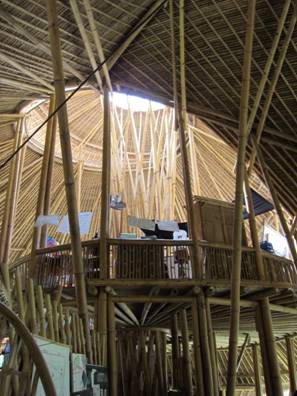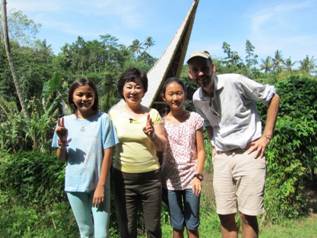A school was established in 2008, near Ubud, Bali, Indonesia, built on the ambitious concept of maximizing students’ autonomy and creativity through education in an environment surrounded by nature. It is called the Green School.
 270 students ranging from preschool to high school boys and girls currently attend the school. The unique aspect of this school is that its campus buildings are so artistic, constructed with thick bamboo. The beauty of their ecological setting is overwhelming. The profile of the campus building – two three-story units combined – looks like a pavilion at an ecology and sustainability world expo for which visitors from all over the world would queue. There are no walls or windows in the classrooms so sometimes the direct effects of rain and wind are felt. Additionally, the school has a library and computer room.
270 students ranging from preschool to high school boys and girls currently attend the school. The unique aspect of this school is that its campus buildings are so artistic, constructed with thick bamboo. The beauty of their ecological setting is overwhelming. The profile of the campus building – two three-story units combined – looks like a pavilion at an ecology and sustainability world expo for which visitors from all over the world would queue. There are no walls or windows in the classrooms so sometimes the direct effects of rain and wind are felt. Additionally, the school has a library and computer room.
The goal of this school is to empower and inspire children of the 21st century so that they have the strength and leadership ability to carry out their responsibilities as citizens of this Earth. In addition to standard academic course contents, students attend such practical works as organic farming, raising farm animals, and making chocolate. In order to promote their relationship with Bali’s local culture, the school offers a scholarship program by which 19 local children are studying in the school as scholarship recipients. I thought that was nice.
Of course, the school’s electrical power is produced by its solar power generator. As there is no wall, you can see the panoramic view in the distance. I saw many children studying in the bamboo classroom with no shoes on, which made me realize they were close to nature. The campus is on 8 hectares of land along the Ayung River. Millennium Bridge, a roofed bridge whose appearance represents Bali, runs across the river and leads to guesthouses.
The annual tuition is about 600,000 yen. The fee is considerably less expensive than that of the average international school, which is about 3,600,000 yen, but more expensive than schools in Indonesia. I met and spoke with Green School’s founder Mr. John Hardy. Regarding the school’s concept he said things like, “Families all over the world come to this school, which is still developing. Generally, common schools provide students with a cramming type of education, which makes children’s eyes seem lifeless. Those schools are like jail, where you are treated as an outsider if you don’t do as you are told. You can’t call that education. Here, students work on research of their own making about various themes, and they summarize the results with computers and present the report in front of class members.”
While I was visiting the school, an independent research study on “fish” was taking place, and on the day of the Marine Day Festival, a 12 year-old student made a presentation about how we can increase the population of specific fish species whose numbers are decreasing. In a math class, children in same grade played an online math test practice game. When I saw them having fun studying math, I was impressed that, since they live in the period in which they can access the world via computers, they didn’t fall behind in their high-level academic performance but have overcome the challenge of developing both their individuality and fundamental capabilities.
It’s good to educate children in an ecological environment but it can be a problem when children mature to college age and discover their academic performance insufficient. In Green School, 7 students took college entrance exams and all were accepted by the college of their choice, the results giving the school further confidence.
Meals provided in the school were tasty and free from food additives. I was thrilled by the mere fact that the children were healthy and free of soft drinks and junk food. The school cafeteria was available to adults, serving tasty organic salad with organic bread, which was all really delicious with the ingredients harvested from the school farm. I fully understood why the meals were so delicious. I noticed some Japanese children there, studying in a relaxed way. I thought that people in their situation would come to be able to speak English fluently and become promising youths after graduating from college.

